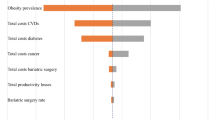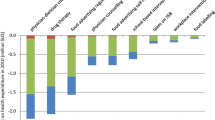Abstract
To effectively control the growth of medical expenditure, Bureau of National Health Insurance (NHI) of Taiwan has taken many measures, including the Reasonable Number of Outpatient Services, Ceiling Price, Global Budgets, Strategic Analysis and the Excellence Plan; however, these measures can only scratch the surface. Due to the change of life style and the deteriorating condition of over-nutrition and obesity, people now have a higher risk of diabetes, hypertension, hyperlipidemia, cardiovascular disease, gallbladder disease, cancer, gout, arthritis, and so on, which leads to higher medical expenditure. Therefore, good civil preventive health care is regarded as the solution of surging medical expenditure. According to NHI’s statistics, the annual medical expenditure of diabetes is about 13 billion NT dollars. Among these diabetics, over 95% are affected by type 2 diabetes mellitus; at least two-thirds—over 80% according to some researches—are overweight or obese. The research says, losing 5% to 10% of the original body weight can lower the risk of chronic diseases effectively; also, giving early therapy for obesity can reduce the complication probability, thus for avoiding the waste of medical resources. By applying influence diagrams of Bayesian Network and Utility Expect of statistics, this paper evaluates the medical expenditure of Taiwan’s NHI under the circumstances of providing and not providing benefit for weight-loss outpatient services. The result of this research is that the cost of not providing benefit for weight-loss outpatient services is 3.4 times of the contrary. Therefore, if Taiwan’s NHI provides reasonable benefit for weight-loss outpatient services, not only the risk of people suffering from diabetes, hypertension, hyperlipidemia, cardiovascular disease, gallbladder disease, cancer, gout, arthritis, etc. will go down; but also the medical expenditure can be effectively reduced.



Similar content being viewed by others
References
Mokdad, A. H., Ford, E. S., Bowman, B. A., Dietz, W. H., Vinicor, F., Bales, V. S., and Marks, J. S., Prevalence of obesity, diabetes, and obesity-related health risk factors. JAMA. 289:76–79, 2001. 2003.
American Academy of Pediatrics (AAP), Statement from the American Academy of Pediatrics for the Senate Subcommittee on Competition, Foreign Commerce and Infrastructure: The Rise of Childhood Obesity. Presentation to US Senate, 2004.
Bell, G. I., and Polonsky, K. S., Diabetes mellitus and genetically programmed defects in β-cell function. Nature. 414:788–791, 2001.
Bray, G. A., Jacque, L., Shuji, L., and Masashige, S., Diet and obesity. Jophan Scientific Societies Press, Tokkyo, 1985.
Bruno, G., Cavallo-Perin, P., Bargero, G., Borra, M., Calvi, V., D’Errico, N., Deambrogio, P., and Pagano, G., Prevalence and risk factors for micro- and macroalbuminuria in an Italian population-based cohort of NIDDM subjects. Diabetes Care. 19(1):43–47, 1996.
Collins, V. R., Dowse, G. K., Plehwe, W. E., Imo, T. T., Toelupe, P. M., Taylor, H. R., and Zimmet, P. Z., High prevalence of diabetic retinopathy and nephropathy in Polynesians of Western Samoa. Diabetes Care. 18(8):1140–1149, 1995.
Cooper, G. F., and Herskovitz, E., A Bayesian method for the induction of probabilistic networks from data. Mach. Learn. 9(4):309–347, 1992.
Cowell, R. G., Dawid, A. P., Lauritzen, S. L., and Spiegelhalter, D. J., Probabilistic networks and expert systems. Springer, New York, 1999.
Howard, R. A., From influence to relevance and knowledge. In: Oliver, R. M., and Smith, J. Q., (Ed.), Influence Diagrams, Belief Nets, and Decision Analysis. New York: John Wiley and Sons, 1990.
Jensen, F., Jensen, F. V., and Dittmer, S. L., From influence diagrams to junction trees. In Proceedings of the 10th Conference on Uncertainty in Artificial Intelligence, 1994.
Flegal, K. M., Graubard, B. I., Williamson, D. F., and Gail, M. H., Excess deaths associated with underweight, overweight, and obesity. JAMA. 293:1861–1867, 2005.
King, H., Aubert, R. E., and Herman, W. H., Global burden of diabetes, 1995–2025: Prevalence, numerical estimate, and projections. Diabetes Care. 21:1414–1431, 2001.
Kopelman, P. G., Obesity as a medical problem. Nature. 404:635–643, 2000.
Lee, Y. C., The analysis of fat-control service in hospital, Unpublished Master dissertation. National Yang-Ming University, Taiwan, 2002.
Livingston, E. H., Obesity and its surgical management. Am. J. Surg. 184(2):103–113, 2002.
Maggard, M. A., Shugarman, L. R., Suttorp, M., Maglione, M., Sugerman, H. J., Livingston, E. H., Nguyen, N. T., Li, Z., Mojica, W. A., Hilton, L., Rhodes, S., Morton, S. C., and Shekelle, P. G., Meta-analysis: Surgical therapy of obesity. Ann. Intern. Med. 142:547–559, 2005.
McGarry, J. D., What if Minkowski had been agesusic? An alternative angle on diabetes. Science (Wash. DC). 258:766–770, 1992.
Meyer, J., Phillips, M. H., Cho, P. S., Kalet, I., and Doctor, J. N., Application of influence diagrams to prostate intensity-modulated radiation therapy plan selection. Phys. Med. Biol. 49:1637–1653, 2004.
Nease, R. F., and Owens, D. E., Use of influence diagrams to structure medical decisions. Med. Decis. Mak. 17:263–275, 1997.
Richard, E. N. (ed.), Learning Bayesian networks, USA: Pearson Prentice Hall, 2004.
Klein, S., Sheard, N. F., Pi-Sunyer, X., Daly, A., Wylie-Rosett, J., Kulkarni, K., and Clark, N. G., Weight management through lifestyle modification for the prevention and management of type 2 diabetes: Rationale and strategies: A statement of the American Diabetes Association, the North American Association for the Study of Obesity, and the American Society for Clinical Nutrition. Diabetes Care. 27:2067–2073, 2004.
Shachter, R. D., Evaluating influence diagrams. Oper. Res. 34(6):871–882, 1986.
Szolovits, P., and Square, T., Uncertainty and decisions in medical informatics. Methods Inf. Med. 34:111–121, 1995.
Tsai, S. T., The current state and reflection of diabetes care in Taiwan. Clin. Med. 45:316–320, 2002.
Wei, J. N., An epidemiological study on diabetes mellitus in children and adolescents in Taiwan, Unpublished Ph.D. dissertation. National Taiwan University, Taiwan, 2002.
World Health Organization (WHO), Quantifying selected major risks to health. In: World Health Report: Reducing Risks Promoting Healthy Life. Geneva: World Health Organization, 2002.
Yan, S. H., The analysis of organizational strategies on department of weight-loss in hospital, Unpublished Master dissertation. I-Shou University, Taiwan, 2002.
Author information
Authors and Affiliations
Corresponding author
Rights and permissions
About this article
Cite this article
Wu, F., Sun, PR. & Chang, CC. Apply Influence Diagrams for Utility Analysis of Paying the Weight-Reducing Expenses: A Case Study in Taiwan. J Med Syst 35, 105–111 (2011). https://doi.org/10.1007/s10916-009-9346-x
Received:
Accepted:
Published:
Issue Date:
DOI: https://doi.org/10.1007/s10916-009-9346-x




